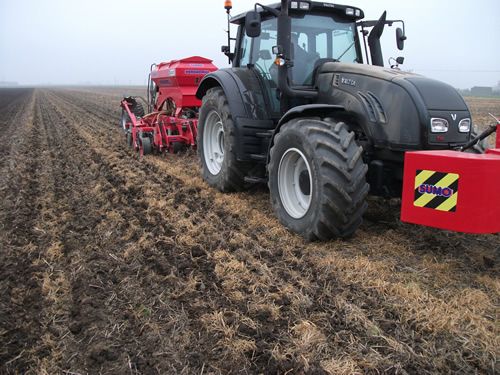
Pea establishment trials in Cambridgeshire this year using Sumo’s Versadrill have shown that minimum tillage established crops have yielded as much as some conventional plough-based establishment operations.
As a result, as well as proving to be a low cost method of establishing peas, with future EU legislation potentially paving the way for a ban on over-wintered ploughed land remaining fallow, the system could offer pea growers a viable option for keeping this important spring crop in the rotation while retaining over-wintered stubble.
Last autumn, in conjunction with the Processors and Growers Research Organisation (PGRO), Cambridgeshire farmer Mike Wakeham set aside 12 hectares of heavy silt clay land on his 170 hectare farm at Benwick, near March. Half the area was ploughed, the other half remained as winter wheat stubble and, with minimal surface disturbance, was subsoiled in the autumn.
Six different pea establishment systems in the spring were compared, four based on the autumn ploughed land using a variety of spring cultivations and drill options, and two using direct drill and minimum tillage systems on the over-wintered stubble with the Versadrill.
The variety Genki was drilled on March 15, at a rate of 330kg/ha, and all six different establishment systems were taken to yield at harvest with costs and net margins calculated.
The farm’s traditionally used plough-based pea establishment system of a pass with a front-mounted press and cultivator, followed by a Suffolk coulter drill, delivered the highest yields in the trial (7.45t/ha) and highest net margin (£1210). However, the plot established by the 3-metre Versadrill with a minimum tillage setting and drilling into stubble yielded a respectable 6.48t/ha, statistically the same as three other plough-based operations in the trial.
In terms of net margins, when taking additional environmental stewardship payments in the ELS over-wintered stubble Option into consideration (£30/ha), the minimum tillage approach with the Versadrill (£1040/ha) was close to the second highest net margin produced by an autumn plough/spring cultivations/Versadrill approach (£1052/ha), and considerably more than two other plough-based establishment systems in the trial.
Trial host Mike Wakeham feels that, overall, it has been a successful look at the minimum tillage establishment of peas, however, before fully endorsing the system, he believes land management during the spring needs to be carefully addressed so as not to have a knock-on effect into minimum tillage-established wheat the following autumn.
Sumo drill specialist Marcus Ainley says that the Versadrill’s success in establishing peas via minimum tillage is down to the drill’s soil loosening ability and accuracy of seed placement. "We’ve designed the leg and loosening points at the front of the drill to have minimal soil disturbance but maximum lift. This fractures the soil down to 8-10 inches, rather than disturbing it too much, and leaves a nice tilth on stubble," he explains.
The drill’s Moore system discs then cut open the slot for the seed to be planted at a precise depth, prior to press wheels firming the seedbed and giving good seed-to-soil contact, he says.
Mr Ainley adds that the Versadrill is the only drill that deep loosens the soil at the same time as drilling, and by not disturbing the stubble between the rows reduces the likelihood of chitting yield robbing weeds, a point backed up by the PGRO’s technical officer Jim Scrimshaw. "In the trial, broad-leaved weeds didn’t seem too bad on the stubble-drilled plots and this is an indication that their growth was restricted by minimal soil disturbance and straw coverage on the surface," he explains.
Nick Blanchard, who farms at Beeford near Driffield in Yorkshire has been using a 4-metre width Versadrill to drill peas onto ploughed land for the past two seasons.
Following a few teething problems with the drill’s metering system to start with, despite very dry spring weather in 2010 and 2011 peas have established very evenly, he says.
"The first season using the drill for peas was all about trial and error, but we have found it a simple way to put peas in the ground at the right depth," he points out. "A lot of other growers in the area had crops suffer in the dry weather during 2010 because they didn’t have the weight of drill to go deep enough. We were drilling at 5" that season and straight into moisture," he explains.
"Our land is strong, and it has yielded well the last 2 years so it’s a system we’ll be sticking with," adds Mr Blanchard.
Marcus Ainley concludes: "We’ve seen from the trial earlier this year that drilling peas into plough or stubble with the Versadrill is a viable option in terms of yields compared with more conventional, plough-based/ drill establishment systems, but the lower establishment costs on offer are also key.
"In the trial, the minimum tillage system reduced establishment costs by an average of £27/ha compared with all four plough-based operations.
"You’re not going to get quite as many acres completed in a day against a standard drill that follows conventional cultivations, but you only have to go over the field once with the Versadrill," he says.
